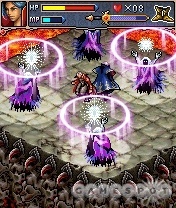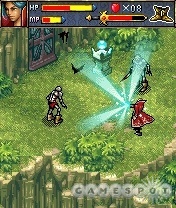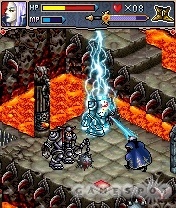Might and Magic has a long legacy on the PC as a role-playing game series that, along with Ultima and a few others, set the standard for quality adventure games--and then helped maintain those standards for years. However, the new mobile version of Might and Magic isn't a role-playing game; it's an action adventure game. But more importantly, it features all the depth and high quality for which the Might and Magic series used to be known. Gameloft has essentially created its own Legend of Zelda with this game, which represents an excellent action adventure offering with role-playing overtones.

Might and Magic centers around Ewan, an earnest fighter who is out to save his kidnapped king. He meets the elfin archer Lorean and the changeling Kayu early on, and from there, the plot twists and turns like a medieval soap opera. The story is told via sequences that are presented between levels filled with inspired dialogue and Braveheart-style war scenes.
The game is spent juggling between the three characters, solving puzzles, and battling enemies, like bats, zombies, and ogres. The story is linear, but the levels are vast. Even the first level is significant in size, and each subsequent one only grows more complex from there.
The most striking aspect from Might and Magic's collection of many strong qualities is its graphics. You view the action from an isometric perspective, like in Diablo or other action RPGs. As you explore, you'll see a lot of great detail, such as lava bubbles that appear beneath your feet; rocks that seem to show years of erosion; and ogres that take up most of the screen with their attacks. The bright, crisp colors add to the game's beauty. The animation is top-notch, even when there are several things happening at once. The sound is surprisingly minimal, but it's effective just the same. There is no music. Sound effects, however, are strong and appropriate--like when finding a new magic item or defeating a foe, for instance.
The actual screen layout is ergonomically perfect. All major information is regulated to the top of the screen, thereby taking up very little of the game area but still remaining detailed and clear. The left corner shows a sharp profile of your current character, followed by hearts that represent health. Next is a power-up meter, followed by an icon showing the currently readied item or magic power.

Might and Magic's controls take a bit to adjust to because of the isometric view. Key 1 makes Ewan jump, while 3 uses the current character's item or special power. Items and powers are selected by pressing 7 or 9. Key 5 executes an attack, whether it's by sword (for Ewan and Kayu) or by arrow (for Lorean), and it can be held down for charged attacks. Key 0 switches between characters when more than one is present. Complication enters the picture whenever movement in the game is involved, because the cardinal directions are at angles. You basically have a choice between two control setups: A, which assigns the diagonally-up-right direction to key 2, or B, which assigns the diagonally-up-right direction to key 6. The other keys are changed accordingly. Movement becomes fairly intuitive after a few games, but it would have helped if Gameloft let players assign their own keys as opposed to having them choose one from only two set options. For instance, some may prefer having the corner keys (1, 3, 7, 9) as the diagonal buttons.
Gameloft seemed to have predicted any possible challenges, though, because Might and Magic makes a serious, quite remarkable effort to make you feel right at home throughout the game. When a new item is acquired, a brief interlude gives you the information on how it is used. Often when confronting a unique obstacle, a small icon will highlight where you should be located to resolve the situation, in addition to revealing what key to press. Then, as the game progresses, the hints trail off, eventually allowing you to fend for yourself.
The puzzles themselves are interesting and challenging, rivaling comparable titles on consoles. The game begins with traditional Zelda-inspired challenges, like having to move the correct blocks to open passageways, as well as having to either hit switches or destroy all enemies to get a specific key. Later areas require some considerable thought and, in some cases, switching between different characters. For instance, one area is blocked by iron gates, and, despite the numerous floor switches, the doors can't be opened. To get through, you must move Kayu to the first gate and then have her transform into her fog form. However, since she can't move in that form, you must use Ewan's wind power to blow her through the crevices of the gate. This is surprisingly interesting stuff.

Attacking enemies requires creativity as well. The electricity-shooting zombies only fire in the cardinal directions, so hitting them at an angle is the key to survival. The huge ogres are more difficult to contend with, because they spin their maces whenever you get close. Initially, you must toss a torch at them to knock them down, and then you can attack them while they're dizzy. Later, magic like Ewan's wind tornadoes can disable them. The ability to make little decisions like these gives the game a sense of freedom of choice, even though the adventure itself is linear.
The items are a hearty laundry list of RPG staples, like medicinal herbs for healing and hearts for a longer health bar. Ewan, in particular, finds useful weapons along the way, like iron boots that allow him to walk on spikes. The grappling hook is the item that is the most fun to use, because it can be used Indiana Jones-style to reach higher places and traverse bottomless pits.
Might and Magic is an addictive game that has that difficult-to-achieve balance between tough situations and appropriate reward. We didn't find a moment of unfair gameplay, and the more difficult areas--at least early on--were supplemented by excellent instruction. Basically, the game flows incredibly smoothly.
Gameloft has created one of the best cell phone adventure games ever--and it's one that's rivaled, ironically, only by its own Prince of Persia: The Sands of Time. Both are great games, but while Prince of Persia was an ode to its own heritage, Might and Magic is an ode to the action adventure genre itself.